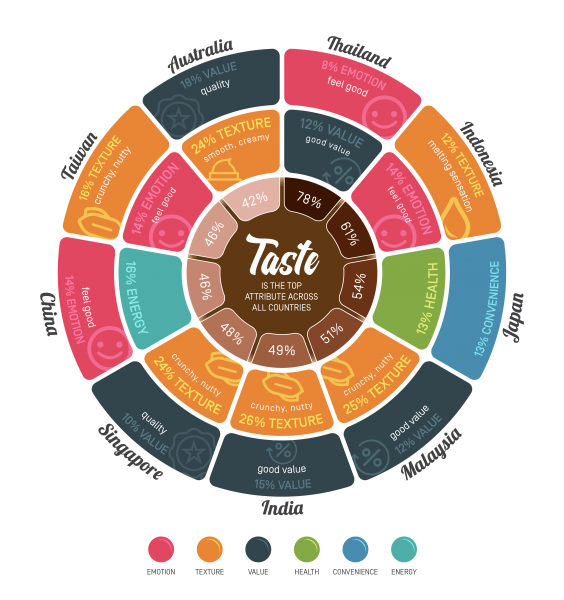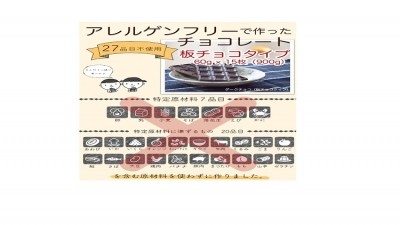APAC not a ‘universal market’: Asia’s multifaceted taste and texture preferences for chocolate

The company’s Singapore subsidiary asked consumers in China, Indonesia, Thailand, India, Singapore, Indonesia, Malaysia, Japan, Taiwan and Australia what they look for when purchasing chocolate.
It says the research will help global chocolate firms decide whether to position themselves as a tasty low-cost brand, an energy-boosting snack or a low-calorie indulgence.
“Not treating the APAC region as a single idea; a universal market to target, is a good starting point to grow market presence and earn the consumers’ heart,” said Patrick Young, insight director at Kadence International.
“It might come as a no-brainer that taste came out top. But there were some interesting country differences, “ he said.
Thailand: Taste is almost all that matters
Taste accounted for 78% of what Thai consumers look for in chocolate, according to Kadence’s research.
“To them really nothing else matters,” said Young, adding that respondents advocated sweeter brands such as M&M’s and Hershey when asked which products met their need for taste.
But for countries outside Thailand, taste accounted for just 46% of consumers’ stated preferences.
“What we have also found is that consumers across different countries have different interpretations of what makes chocolate ‘tasty’,” said Young.
“Singaporeans and Indonesians like their chocolates sweet, much higher than the Taiwanese. Whereas the Taiwanese look more for a chocolate aroma when judging its tastiness.“
Texture: Smooth or crunchy?
Chocolate texture was also cited as a key parameter throughout Asia and was the number two preference behind taste in some countries such as Australia (24%), Singapore (27%), India (26%), and Malaysia (25%).
But Kadence said there were again contrasting views on what constitutes good texture.
“For Australians they value a silkiness; a smooth and creamy chocolate defining good texture. A fact clearly evidenced the brands mentioned: Cadburys and Lindt, two smooth and creamy chocolate brands,” said Young.
“The same cannot be said for Malaysians or Singaporeans, who like their chocolates to have a bit of crunch in them,” he continued.
The analyst added that chocolates with nuts and cookie fillings were well-received in Singapore, which explains Ferrero Rocher’s popularity among Singaporean respondents.
China favors energy; Taiwan wants feel-good factor
However, in some countries, need states outweighed texture.
“In China, consumers care more about meeting their rational needs – having the energy boost from chocolates came in second (16% versus the average of 5%), “ said Young, adding that Snickers’ energy campaign was clearly paying off in China.
Kadence found Chinese consumers were less concerned about the price and paid closer attention to quality.
But in Taiwan, Kadence found the focus was far more emotional and less about energy.
“They are after the feel-good factor they get from a chocolate bar. It therefore makes sense that a firm family favorite, Glico, comes to mind the most when thinking of more emotional needs from chocolate,” said Young.
Kadence also found 68% of Taiwanese consumers want their chocolate to be at wallet-friendly prices.
Japan’s health conscious consumers
The research firm found that Japanese consumers were paying closer attention to their diets than other markets. It said it was the only nation “deeply concerned with health when it comes to chocolate”.
Calorie content was the second most cited preference for Japanese consumers, it found.
“Ask anyone who has been to Japan and they would know that the Japanese are diligent and almost ritualistic in keeping up their appearance and being health-conscious,” said Young.
The analyst added that flavors such as tea and fruit were popular in the Japanese market and said many brands featured these flavors rather than the sole taste of chocolate.
Still room for local brands
Young said Asia’s varying chocolate preferences meant there was at present no winning brand across the region.
Kadence found Cadbury was the most mentioned brand, but mainly in pockets such as India, where brand owner Mondelēz dominates.
By contrast Cadbury did not make the top five brands mentioned in China.
“Even one of the world’s chocolate heavyweights has not cracked the APAC market just yet,” said Young.
“In a number of markets, it is often the more local brands and players who dominate – Glico in Taiwan; Dove in China; Meiji in Japan – suggesting local brands are currently doing a better job of understanding their consumers’ particular palate,” he continued.
The analyst said local brands had a sense of nostalgia as they had been consumed by many respondents in childhood.
“The feeling of nostalgia, familiarity is something that cannot be filled only with the taste or texture; and this could be one aspect that a lot of global brands and confectionary giants are neglecting in their market entry,” he said.
Further reading from the archives... China no longer chocolate’s ‘beacon of hope’? Why brands may need to rethink BRIC strategy

















